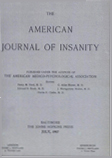SCHIZOPHRENIC PSYCHOSES
Abstract
1. 100 schizophrenic reactions in soldiers were studied immediately after the onset of psychotic symptoms.
2. Paranoid reactions occurred more frequently than all other reactions combined, followed in order by hebephrenic, unclassified or mixed, catatonic and simple types.
3. The average age on hospitalization was highest in the paranoid group, followed by hebephrenic, catatonic, simple and unclassified reactions.
4. The average length of service in the army was greatest in the paranoid reactions and least in the catatonic.
5. In 92 per cent, an obvious mental disorder in the individual resulted in psychiatric study. In 4 per cent the patients themselves requested psychiatric aid; and in 4 per cent a psychosis was undetected before admission to the hospital for other causes.
6. In 25 per cent of all cases, the outspoken psychotic symptoms were preceded by neurotic symptoms of one month to 5 years duration. A psycholeptic attack initiated symptoms in two individuals.
7. Neurotic symptoms merged into psychotic symptoms, co-existed with psychotic symptoms, or remained as residuae after the regression of psychotic symptoms.
8. Strong family ties existed in 40 per cent of the group as a whole, and consisted of deep attachments or aversions to parents or siblings.
9. Prepsychotic schizoid personalities were most common, followed in order by syntonic, psychopathic and neurotic personalities. Oral and anal types of personality each occurred once.
10. Apparent precipitating factors, both latent and immediate, involved abnormal sexuality in 50 per cent, hostility to the environment in 13 per cent, alcohol in 9 per cent and homesickness in 4 per cent.
11. Rapid improvement occurred in 44 per cent of the paranoid reactions, in 28 per cent of the unclassified or mixed reactions, in 10 per cent of the hebephrenic, and no improvement occurred in any of the catatonic reactions during the short period of observation.
Access content
To read the fulltext, please use one of the options below to sign in or purchase access.- Personal login
- Institutional Login
- Sign in via OpenAthens
- Register for access
-
Please login/register if you wish to pair your device and check access availability.
Not a subscriber?
PsychiatryOnline subscription options offer access to the DSM-5 library, books, journals, CME, and patient resources. This all-in-one virtual library provides psychiatrists and mental health professionals with key resources for diagnosis, treatment, research, and professional development.
Need more help? PsychiatryOnline Customer Service may be reached by emailing [email protected] or by calling 800-368-5777 (in the U.S.) or 703-907-7322 (outside the U.S.).



